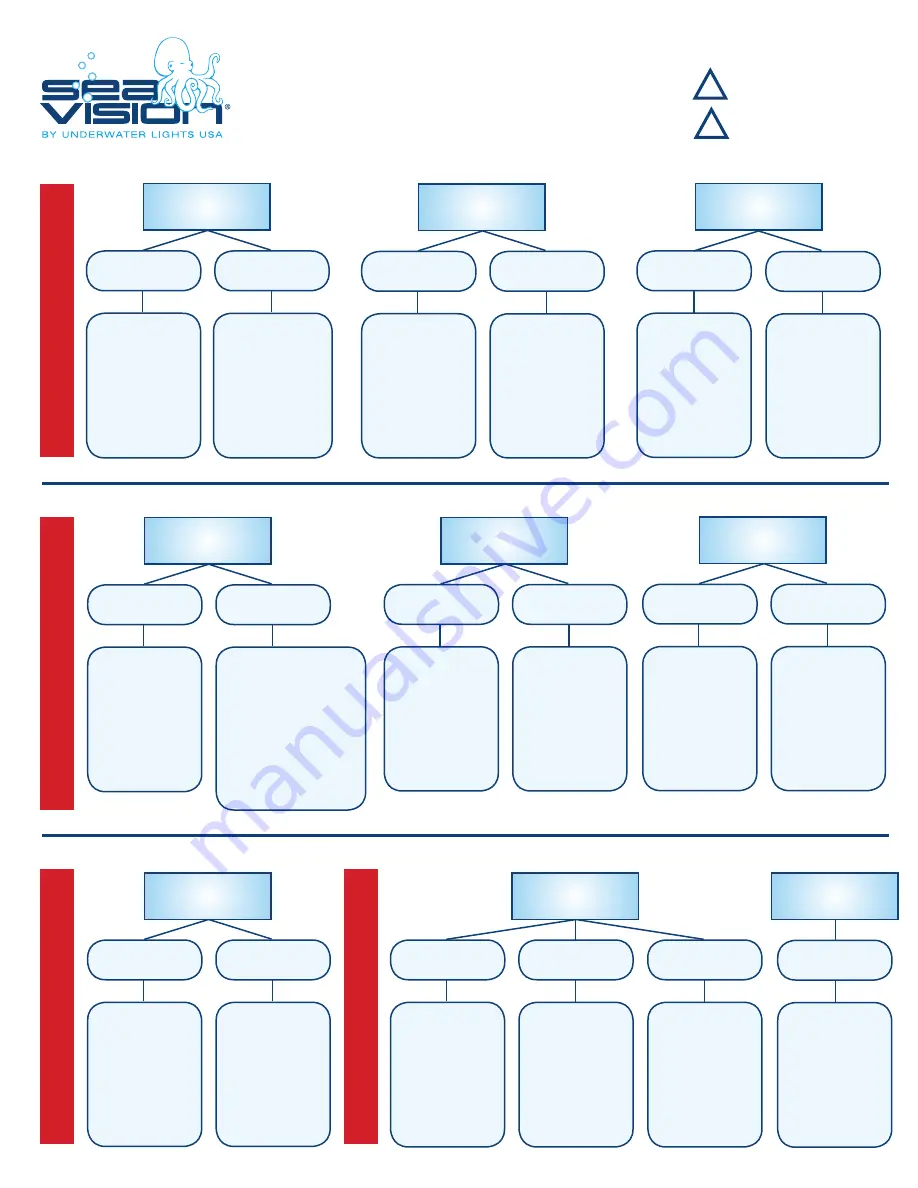
Light does not
turn on.
Bad bulb and/or ballast
Loss of power to light
- Check bulb by swapping
with known good ballast
or bulb
- Send bulb and/or ballast
to Underwater Lights USA
for bench testing
- Replace ballast and/or
bulb as needed
- Check wires to ballast/
light for loose or
corroded connections
- Check power supply to
ballast/light, ensure
12 or 24 volts present
- Check fuse (SV19 & SV20)
or relay (SV20)
- Switch not able to
handle current
Light flashes but
does not turn on.
Loss of voltage/voltage drop
Ballast is bad
- Check wires to ballast
and/or light for loose or
corroded connections
- Check power supply to
ballast/light, ensure
12 or 24 volts present
- Ensure wire size is
adequate for startup
current
- Check by swapping with
known good ballast,
replace as needed
- Send ballast to
Underwater Lights USA
for bench testing
Light does not
turn on.
Bad bulb and/or ballast
Loss of power to light
- Check by swapping with
known good ballast
or bulb
- Send bulb and/or ballast
to Underwater Lights
USA for bench testing
- Replace ballast and/or
bulb as needed
- Check breaker for underwater
lights
- Check input voltage to ballast
- Check fuse on ballast,
replace if needed
- Check GFI breaker for lights
- Check wires to ballast
for loose/corroded connections
- Check high temp cable
from ballast to light for
loose or bad connection
Light turns on and
lights for a few minutes
then shuts off.
Bulb is bad
Ballast is bad
- Check by swapping
with known good bulb,
replace as needed
- Send bulb to
Underwater Lights USA
for bench testing
- Check by swapping with
known good ballast,
replace as needed
- Send ballast to
Underwater Lights USA
for bench testing
Light flashes but
does not turn on.
Loss of voltage/voltage drop
Ballast is bad
- Check wires to ballast
and/or light for loose or
corroded connections
- Ensure correct input
voltage to ballast
- If on a “daisy chain”,
wire each light directly
to AC power source
- Check by swapping with
known good ballast,
replace ballast if needed
- Send ballast to
Underwater Lights USA
for bench testing
Light turns on and
lights for a few minutes
then shuts off.
Ballast is bad
- Check by swapping
with known good ballast,
replace as needed
- Send ballast to
Underwater Lights USA
for bench testing
Light does not
turn on.
Bad bulb
Loss of power to light
- Check bulb by swapping
with known good one
- Replace bulb
- Corrosion in socket,
clean and retry
- Check voltage to light
and verify there is
12 or 24 volts to it
- Corrosion in socket,
clean and retry
- Check inline fuse
for light
All Lights (except LED)
Water in light.
Condensation in light
Bezel seal is leaking (rare)
- Dry out, clean, apply
Tef-Gel to reflector,
reinstall and observe
- Remove and send to
Underwater Lights USA
if water builds up again
- Remove light and
replace lens gaskets
- Remove light and
send back to
Underwater Lights USA
for repair
Reflector frozen
and does not pull
out of housing.
Reflector corroded
due to condensation/
water intrusion
- Remove light and
send back to
Underwater Lights USA
for repair
HI
D
DC
V
ol
ta
ge
HI
D
AC
V
ol
ta
ge
Ha
lo
ge
ns
Al
l L
ig
ht
s
(e
xc
ep
t
LE
D)
!
Caution do not apply power
to ballast without bulb in place
Caution high voltage output
out of ballast
!
Bulb is bad
- Check by swapping with
known good bulb,
replace as needed
Halogen and HID Troubleshooting
and Repair Guide
Cable gland leaking
- Check cable gland is
tight on cable
- Check cable gland is
tight on cap




















